- Strawberry Begonia: When Is The Perfect Time To Propagate It? - August 15, 2021
- Beefsteak Begonia: Everything You Need To Know About It - August 12, 2021
- Ficus Altissima: How To Identify This Plant From The Ficus Family? - August 2, 2021
Could your interior use a little inspiration? You don’t have to invest in a ton of new furniture or overhaul your entire living space. A little greenery can go a long way. Indoor plants add instant character and personality to any space. Whether your style is bohemian and eclectic or modern and minimalist, you can find one that fits your style and aesthetic.
Is your thumb any color but green? Do not worry! We’ve got you covered. Today, we’re sharing the ultimate guide to helping your botanical babies live long and prosper! We’ll share the best varieties of indoor plants to consider, as well as easy, low-maintenance tips to help you make the most of your new additions.
The History of Indoor Plants: Early Roots
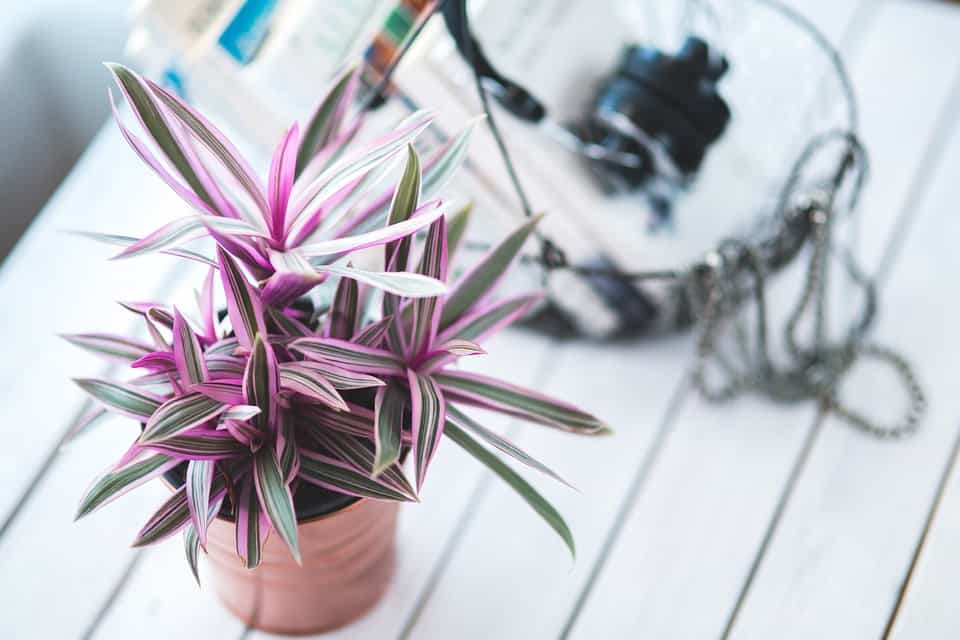
Houseplants might be on-trend and all over social media these days, but the concept is nothing new. In fact, people have been bringing the outside in for centuries. Let’s take a walk back in time to see where it all began.
500 to 400 BC: Ancient Civilizations Bring Gardens Indoors
There are early reports that suggest ancient Greek and Roman civilizations were among the first to use potted plants as interior decor. Between 500 and 400 BC, they grew expansive and colorful gardens, and it wasn’t long before the efforts spread into their living spaces.
Mid-17th Century: Greenhouses Emerge in England
Transporting potted plants is one thing. What about growing plants indoors? While there’s no definite answer as to who initiated this method, English agricultural writer Sir Hugh Plat hints that it might have started in the mid-17th century.
In 1652, Plat wrote a book titled “The Garden of Eden”, in which he suggested that the idea of growing plants indoors might be a viable one. Soon, wealthy homeowners in England began adding greenhouses and conservatories onto their properties.
1800s to 1900s: Glamor and Convenience Reign
From there, the concept of indoor houseplants continued to blossom well into the late 1800s. Anyone familiar with Victorian media has likely seen illustrations of interior furnishings during this era. Most of them feature plants scaling the walls or growing wildly out of containers on the floor.
That particular trend saw a resurgence in the 1970s, where houseplants became synonymous with the lavish, tropical decor that defined the decade. Two decades later, homeowners grew tired of the upkeep, and made the swap to faux plants, instead.
Today: Customizable, Low-Maintenance Beauty
Today, the best indoor plants are those that are fit seamlessly into your existing decor. From the Insta-famous fiddle leaf fig to the small but mighty succulent, homeowners are discovering the ones that make their house feel like a home.
With a few clicks, they can view Pinterest boards full of #houseplantgoals, learn simple care techniques, and even connect with live lawn care personnel for on-demand support. We’ve entered a new era of indoor plant care, and the possibilities are limited only by time and budget.
Read More:
- Fairy Castle Cactus: How To Care For Acanthocereus Tetragonus
- Snow Queen Pothos: How To Get The Perfect Heart Shaped Leaves
- Begonia Maculata Info: Signs That You’re Not Growing It Right
- Peperomia Caperata: How To Cultivate This Tropical Plant?
- Peperomia Ruby Cascade: Is This Plant Perfect For You?
- Peperomia Argyreia: How to Grow The Watermelon Begonia
- Peperomia Ferreyrae: Why Is The Pincushion Peperomia So Special?
- Peperomia Rosso: How Much Maintenance Does This Flower Needs?
- Beefsteak Begonia: Everything That’s Essential To Know About It
- Begonia Pavonina: How to Sprout The Peacock Begonia?
- Peperomia Prostrata: How to Grow The String of Turtles Plant?
- Euphorbia Trigona: Things You Should Know About This Plant?
- Calathea Medallion: Why It So Popular Amongst Plant Lovers?
- Calathea Musaica: Why Is This the Perfect Plant for Pet Parents?
- Calathea Orbifolia: Is It Easy to Care For It?
- Calathea Lancifolia: How to Care for The Rattle Snake Plant Successfully?
- Glacier Pothos: How to Maintain a Healthy Glacier Plant?
- Silver Pothos: What This South Asian Plant Has to Offer?
- Calathea Triostar: Why You Need This Colorful Plant At Home
- Calathea White Fusion: What This Tropical Plant Has to Offer
- Calathea Zebrina: Why You Need This Interesting Plant at Home
- Calathea Makoyana: Where to Find Seeds for This Peacock Plant?
- String of Bananas (Senecio Radicans): How to Grow It From Scratch?
- Marble Queen Pothos: Why It’s A Good Indoor Plant?
- Calathea Roseopicta: How to Care for the Rose Painted Calathea
- Echeveria Elegans: Everything You Should Know of This Polycarpic Plant
- Neon Pothos: Why is This the Ideal Plant For You?
What Are the Best Varieties of Indoor Plants to Consider?
Now that we’ve piqued your interest in growing plants indoors, the real research can begin. As you might imagine, not every plant species is well-suited to thrive outside of the wild. As you prepare to invest in this new hobby, it’s important to know which plants do best in this type of environment.
To help guide your journey, we’ve compiled a comprehensive list of the best varieties of indoor plants around. Even if you’re a beginner, these are made to grow well inside, so you’re already on the right track!
Snake Plant
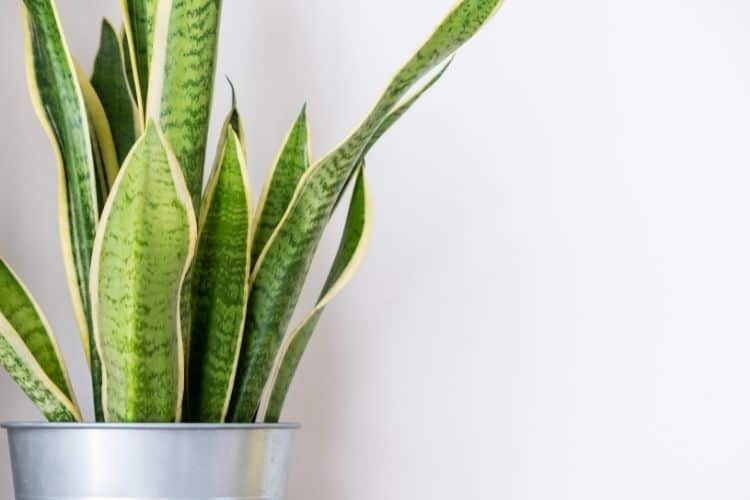
Despite its name, rest assured that this plant doesn’t harbor snakes! Rather, it gets its moniker from the unique, irregular banding on its thin, upright leaves. The light green stripes look similar to snakeskin, though it’s much less creepy!
Snake plants are drought-resistant and hardy, and also look super cool. While they do best near bright lights, they can survive just fine in lower light, so feel free to place yours anywhere you can find an empty space. They’re also great at filtering the air, so try putting one near your bed!
Arabica Coffee Plant
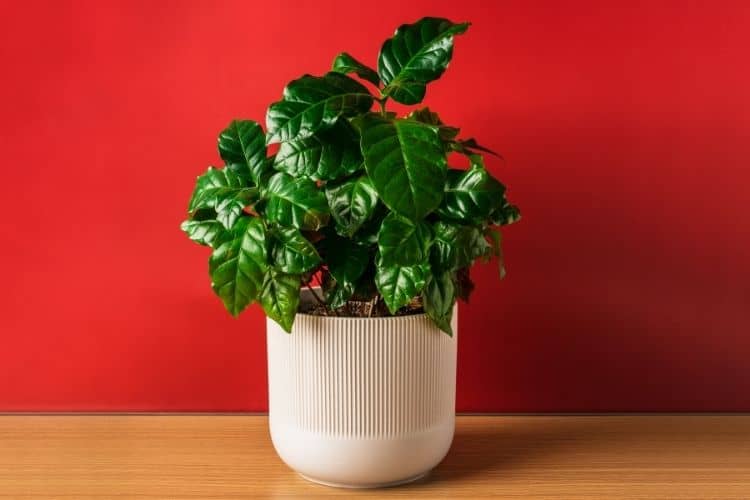
You won’t be able to fill your mug every morning with the beans from your indoor coffee plant, but you could get a few every now and then! These plants have waxy green leaves that are dark green and easy to maintain. The only rule to remember is to keep their soil well-moistened.
If the leaves on your Coffee Plant get too dry, they’ll start to wither and droop. A simple watering will perk them right back up!
Monstera Deliciosa
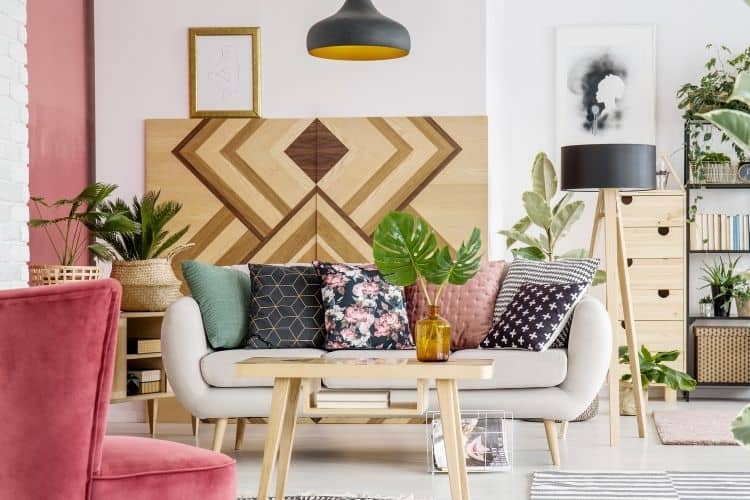
If the name sounds exotic, that’s because it is. These tropical indoor plants are super trendy right now, and for good reason. If you can tend to them enough to jumpstart their growth, they’ll reward you with big, light green leaves that are perfect for the ‘gram.
When temperatures are warm, your Monstera Deliciosa should produce about one new massive leaf weekly! Thriving on bright to medium-indirect light, it only needs to be watered once every week or two. Let the soil dry completely between waterings, and they’ll last forever.
Read More:
- Monstera Standleyana: How to Take Care of It Indoors
- Monstera Deliciosa: How To Identyfy This Plant from Similar Species
- Monstera Obliqua: How to Grow One from Seeds?
- Monstera Dubia: All You Need to Know of This Vining Plant
- Monstera Borsigiana: How to Keep This Plant Strong and Healthy?
- Monstera Epipremnoides: How to Grow Swiss Cheese Plant Successfully
- Monstera Standleyana: How to Take Care of It Indoors
- Monstera Minima: Can This Plant Live In Your Home Conditions?
ZZ Plant
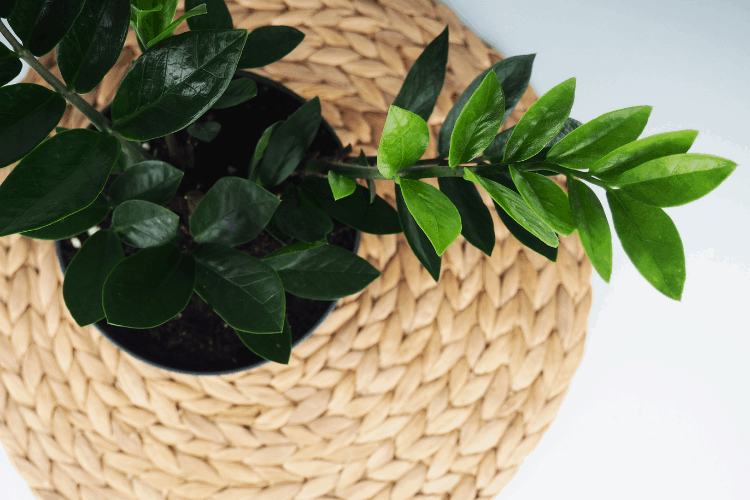
Don’t snooze on this plant! A ZZ Plant is elegant and beautiful but only looks delicate. In reality, this is one of the easiest plants to maintain, as it requires much less water than many others on our list.
The only thing a ZZ Plant really needs is a good amount of direct sunlight, so place it by a window and watch it grow! Don’t have a good sunspot? This species is sturdy and low maintenance and will be just fine in a dimmer area.
Dracaena
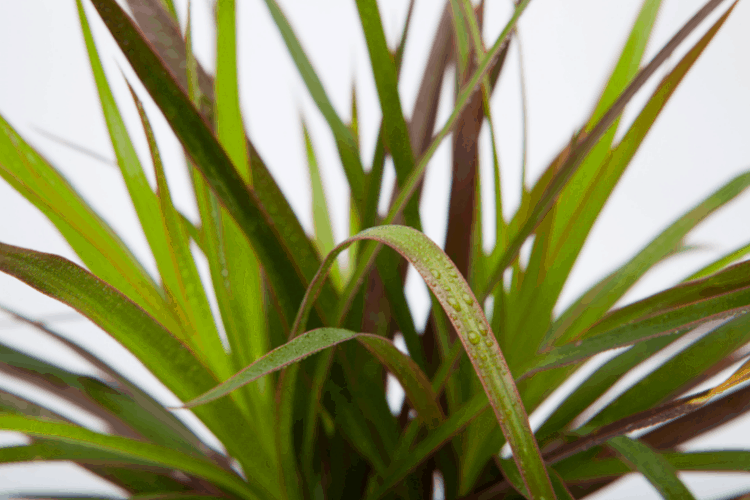
Always on the go? You need a chill houseplant that doesn’t require too much attention.
Enter, the Dracaena.
This adaptable species is easy to please and does well in almost any interior space, except one that gets a ton of direct sunlight. If possible, invest in Draacena Lisa. This species easily adapts to fluctuations in your home’s temperature, as well as exterior season changes that affect light levels. It’s also at the top of the list of plants with excellent air purification qualities.
Rubber Plant
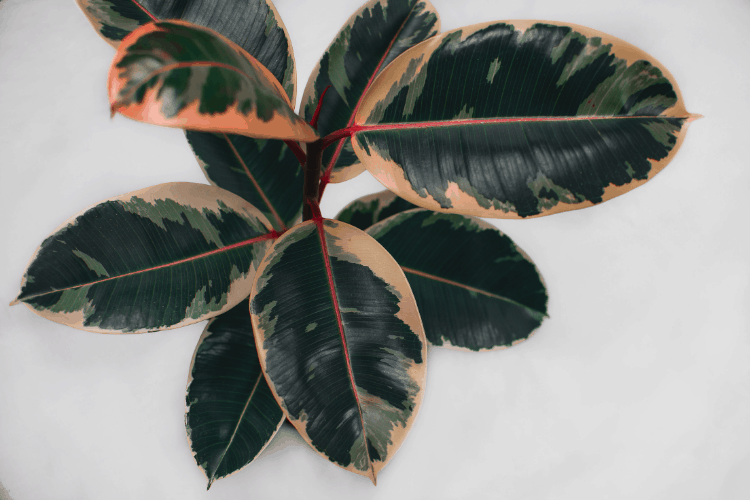
Unfortunately, this plant isn’t actually made out of rubber. It’s a very real, tall plant that grows beautifully when exposed to a steady stream of bright, indirect light.
Feel the soil of your Rubber Plant regularly to check its moisture levels, and only water when it feels dry. Keep in mind that this one can grow halfway up your window, so you may need to transplant it if it outgrows its original planter!
Spider Plant
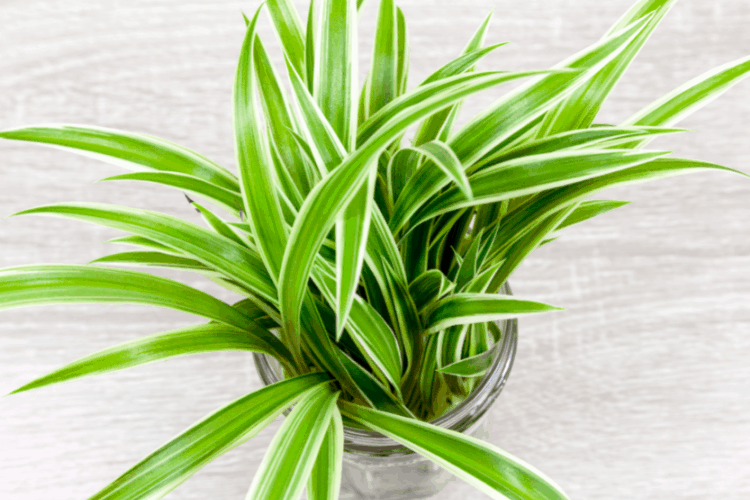
Remember those 1970s jungle-themed interiors we discussed earlier? Spider plants played a big role in that look, and they’re still stylish today.
Named for their long, skinny leaves that resemble arachnid legs, Spider Plants are easy to grow indoors. They need bright, indirect light and do well next to a large window. Before long, you’ll begin to notice that the plant easily propagates, growing baby spiders, or spiderettes, that you can separate to grow new plants!
String of Pearls
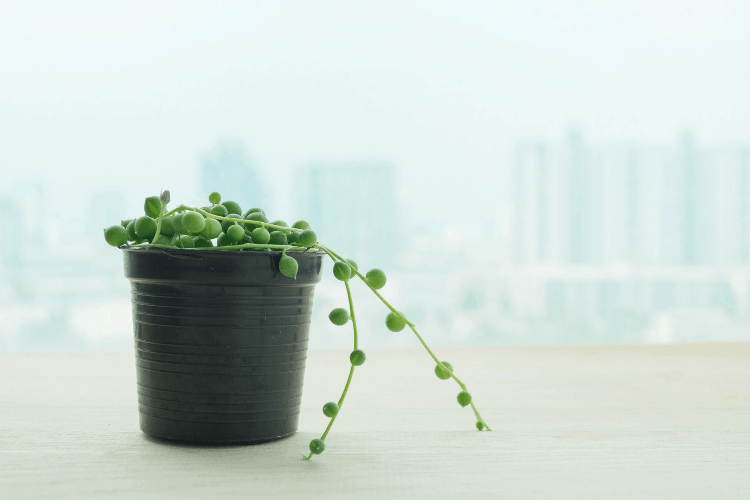
Want to give your home instant modern farmhouse vibes? Fill a basket planter with a String of Pearls plant and give yourself major props. With tiny, round leaves the color of edamame, its strands grow gorgeously down the side of any container.
Place it in bright, indirect light and keep its soil consistently moistened. This particular plant looks gorgeous in a hanging basket!
Bird’s Nest Fern
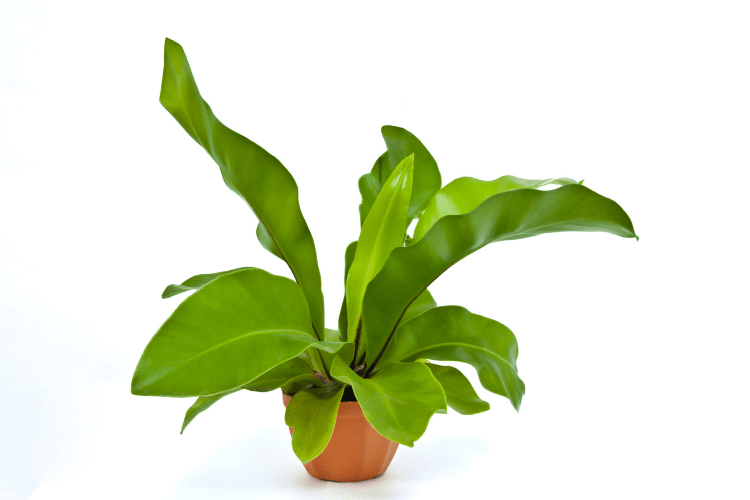
You don’t have to worry about a family of birds taking up residence in your home! A Bird’s Nest Fern has trademark, rippled fronds that are sure to spark conversation anywhere you put it.
Not sure where it will thrive? This species needs indirect light and lots of humidity, making it the ideal addition to any bathroom, as long as there are enough windows to let in some natural light. One bonus to placing it there? This fern is great at filtering out toxic chemicals from the air, so hairspray, cleaners, and fumes from your nail polish remove don’t stand a chance.
Philodendron Green
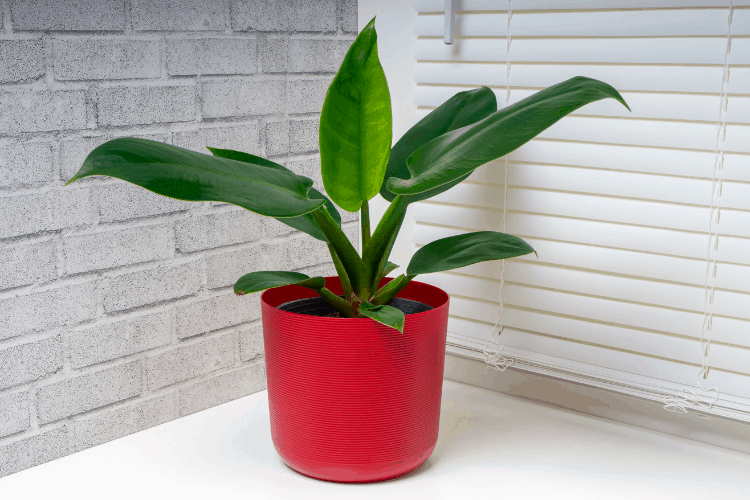
This indoor plant is so easy to grow, it will give anyone confidence that their thumb may actually turn green one day! Featuring unique, heart-shaped leaves and trailing vines, it can easily grow to more than 10 feet long in the right indoor conditions.
For that reason, Philodendron Green looks great perched on a shelf, where its vines can cascade down the side. It’s also easy to prune this plant back into a compact shape.
Read More:
Pothos
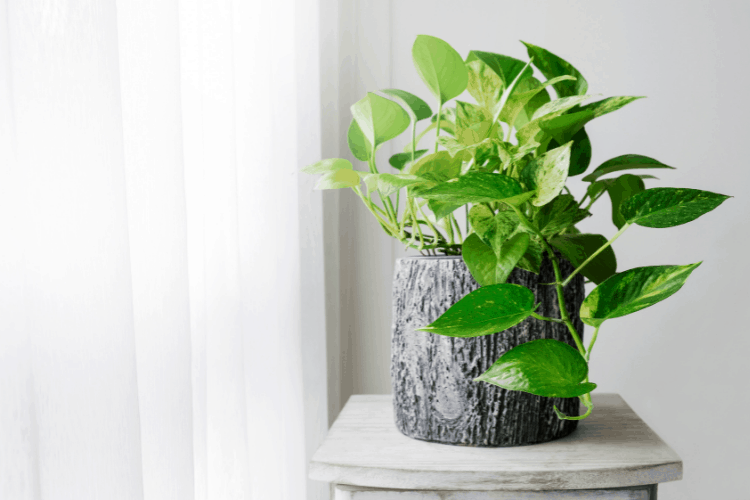
Pothos and Philodendron Green plants look very similar in color and leaf shape. Both usually start small but grow to lengthy proportions when regularly trimmed and watered.
Casually deemed the “cubicle plant”, this is a great starter species for any beginner. It even does well when the air is dry and the lights are low, so it’s nearly impossible to mess this one up.
Read More: Jessenia Pothos: Is This Plant Safe to Keep At Home?
Aloe Vera
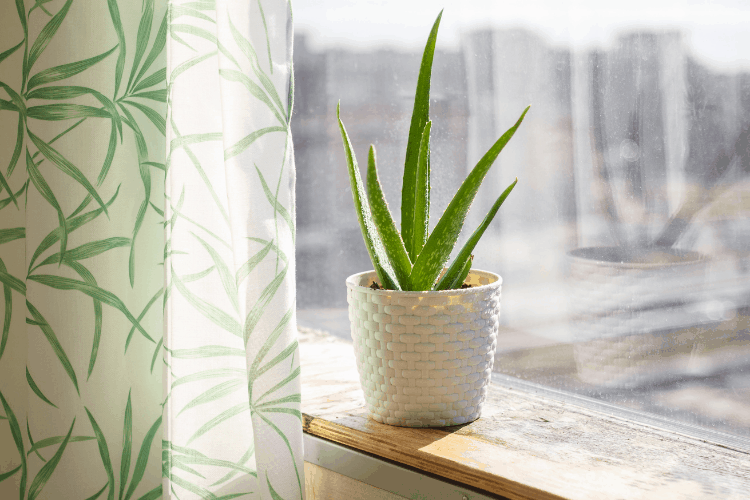
To date, your only experience with Aloe Vera may be the gel you buy at the supermarket to help soothe a summer sunburn.
However, did you know that you can grow this plant right in your own home? Inside of each leaf, you’ll find Aloe Vera juice, heralded for its anti-bacterial and anti-inflammatory properties. If you ever experience a minor burn, simply break one open and squeeze gently.
Put the plant in a bright, well-lit area and let the soil get very dry before watering.
Jade Plant
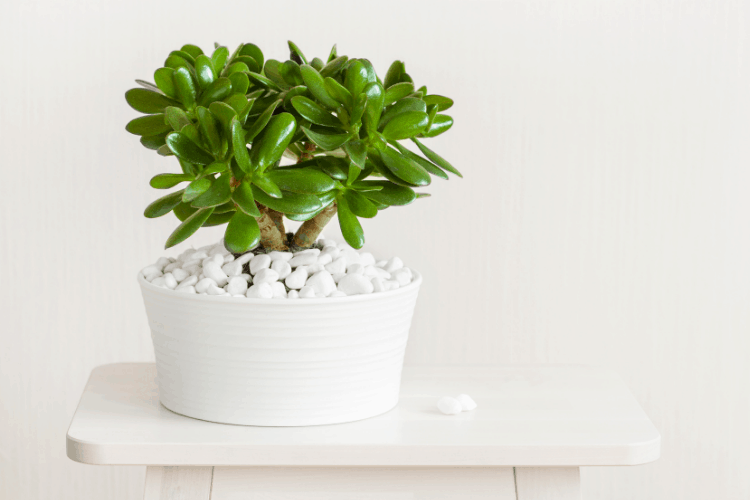
In the right conditions, a Jade Plant can easily fill a tabletop, medium-sized planer, with new leaves growing as old ones fall off.
These plants require very little water and do well in almost any type of lighting or growing environment. Plus, they’re known to live for years, so they’re a great plant to start and learn alongside!
Air Plants
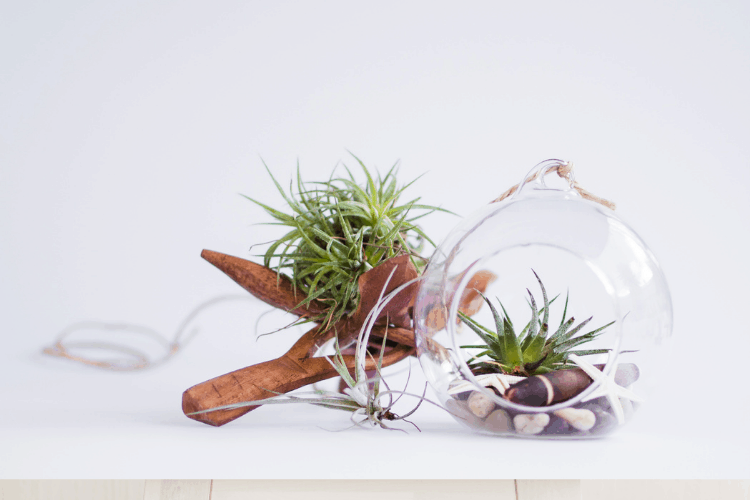
Air Plants are so named because they don’t embed their roots into any type of soil. In nature, you can often spot these plants hanging out on other plants. For instance, they love to hang onto tree trunks!
As they’re used to tropical environments, they love humid temperatures and their brown leaves will let you know when they’re thirsty. Despite common belief, you do have to water your Air Plants. Soak them in warm water for about an hour once a week.
Fiddle-Leaf Figs
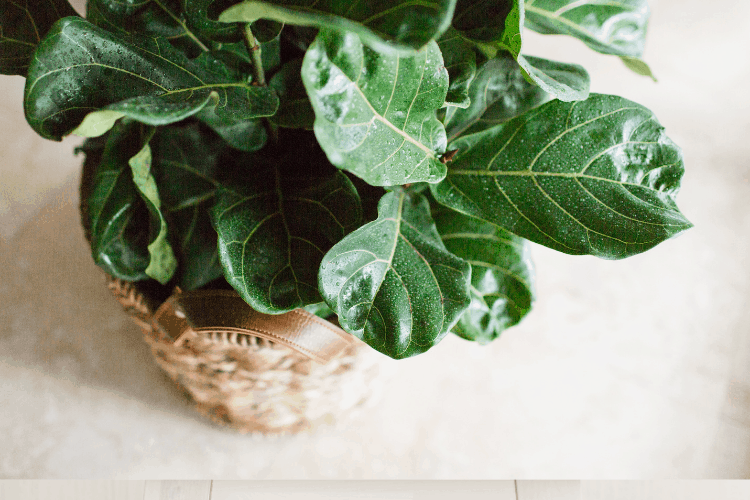
In recent years, Fiddle-Leaf Figs have become synonymous with indoor houseplants, sparking a social media frenzy as everyone from Meghan Markle to Tracee Ellis Ross rocked the trend. Moving into the second half of 2021, that movement shows no sign of slowing down.
Though they’re totally beautiful, Fiddle-Leaf Figs can be a little fickle. They’re especially responsive to any changes in their indoor environment, so they may drop their leaves if moisture or temperature levels start to fluctuate. Put yours near plenty of bright, indirect light and check its water level daily.
The Major Differences Between Each Type of Indoor Plant
When shopping for indoor plants, there are a few key differences to keep in mind. The most important ones are distinctions between:
- Levels of sunlight needed
- Soil moisture levels
- Amount of maintenance required
Some plants, such as the Snake Plant or Jade Plant, will do fine in almost any type of lighting, including low-lit areas. Then, there are others, like the Spider Plant and the Fiddle-Leaf Fig, that need plenty of bright, indirect light to thrive.
At the same time, each plant will have its own needs regarding soil moisture. If you come home with an Arabica Coffee Plant, you’ll need to check the soil often to make sure it doesn’t dry out.
The same applies to other species on this list, including the Bird’s Nest Fern and String of Pearls. If you don’t have the time or energy to water every day, look for a plant that doesn’t need as much water, such as the Monstera Deliciosa or Aloe Vera plant.
Then, there’s maintenance. As we’ve discussed, the Fiddle-Leaf Fig plant requires a keen eye that can check it regularly. If you live a busy lifestyle, this might not be the ideal plant for your home. In that case, stick to a lower-maintenance species, such as an Air Plant.
The Advantages of Indoor Plants
With so many ways to spruce up your interior, why should you consider decorating with indoor plants? Put simply, the science doesn’t lie. Here are a few benefits you can expect from the moment you bring your first #plantbaby home.
Lower Stress Levels
Feeling a little overwhelmed lately? Try adding a few plants to your home office or living room. They can lower your stress levels and make you feel more comfortable and relaxed.
One study tested this theory by asking participants to perform two different jobs: repot an indoor plant, and complete a quick task on the computer. After each task, researchers measured their heart rate and blood pressure, among other stress factors.
Not surprisingly, the computer task caused those factors to spike, while indoor gardening lowered them. In other words, if you’re feeling an uptick in cortisol these days, tending to an indoor plant can help keep those levels in check.
Boost Productivity
If you feel more productive and focused when you’re working around greenery, it isn’t all in your head. In fact, researchers recently found that employees with a greater number of plants in their workspace were more productive and took fewer sick days than those who didn’t have as many.
Could Improve Indoor Air Quality
When people speak on the benefits of indoor plants, this is a common one. Most of the time, these claims are rooted in a particular NASA study conducted in the 1980s.
Then, researchers needed a way to improve the air quality inside of a tightly-sealed spacecraft. They found that houseplants had roots and soil that actively reduced the levels of volatile organic compounds (VOCs) in the air.
Since then, this connection has been met with some caveats. To notice a major difference, you’d need to grow a ton of plants indoors. However, that’s not to say that they can’t help rid the air of certain pollutants and toxins, including formaldehyde and benzene.
Promote Quicker Healing
If you’re recovering from an illness or injury at home, you’ll want to stare at your plants as much as possible!
When we surround ourselves with living energy, we turn our homes into natural sanctuaries that help us feel better, quicker. In this study, they found that patients who recovered with plants in their rooms didn’t need as much pain medicine as those without them. They also enjoyed other healing benefits during their recovery, including:
- Lower blood pressure
- Lower heart rate
- Lower anxiety levels
- Lower fatigue levels
Make Living Areas More Comfortable
Air purification isn’t the only way that indoor plants can make your home more cozy and comfy. The right ones can pull their weight in plenty of other ways as well. When placed strategically, plants can:
- Increase your indoor relative humidity
- Absorb and reduce indoor noise
- Add shade to a bright window to moderate temperature
- Screen and block unattractive areas
If you look around your room and think something feels off, a simple houseplant could be the solution to a more balanced, enjoyable home.
The Disadvantages of Indoor Plants
For the many perks and benefits that they offer, indoor plants do have their drawbacks. Let’s take a look at a few of the disadvantages that can come along with owning and caring for your houseplants.
Time and Maintenance
First, there’s the issue of the time and attention that some indoor plants require. Certain species need regular pruning and timing, while others need you to check their water and sunlight levels on a daily basis. With reports showing that Americans are more stressed and busy than ever before, you may not have the mental or physical energy required for their upkeep.
Still, this doesn’t mean you have to give up on your dreams of owning an indoor plant forever! Simply look for a low-maintenance species, such as a Pothos, and you can enjoy the treat without the time.
Dangers to Pets and Children
If you have little ones running around, it’s important to make sure that the indoor plants you grow are safe for them to touch and be around. The same goes for your babies with furry paws!
This handy list covers seven common culprits that you should keep far away from curious climbers. Some plants, like English Ivy, might look beautiful, but can trigger a range of uncomfortable side effects if ingested, ranging from weakness and vomiting to throat swelling and impaired coordination.
Could Attract Bugs
You want your plants to feel at home in your space, but you don’t want them to become a home. Thankfully, pests usually pop up only when your plant isn’t thriving. For instance, it might become vulnerable if it’s soaked in water, or if its soil is excessively dry.
From aphids and mealybugs to spider mites and gnats, these pests are usually harmless but they can be a major nuisance. Here’s a detailed guide to help you identify and get rid of them, stat.
Could Grow Mold and Fungus
You might think you’re being a diligent plant owner, but zealously overwatering your greenery could cause more harm than good. When the soil is too moist, it creates an ideal environment for mold and fungus to grow.
Not only do these conditions look unsightly, but they could kill your plant if left untreated and pollute the air you breathe. Usually, you can wash little infections right off, though deeper issues may require cutting or removing the damaged area.
Limited Vacation Options
Do you have a trusted friend close by who could watch and tend to your plants while you’re out of town? If not, you may want to rethink your vacation plans.
An especially high-maintenance species might not fare well if it’s left on its own for even a few days. For this reason, it’s important to consider each plant as an investment of time and money, and make sure you’re ready to fully embrace that commitment.
Tips to Help Your Indoor Plants Thrive
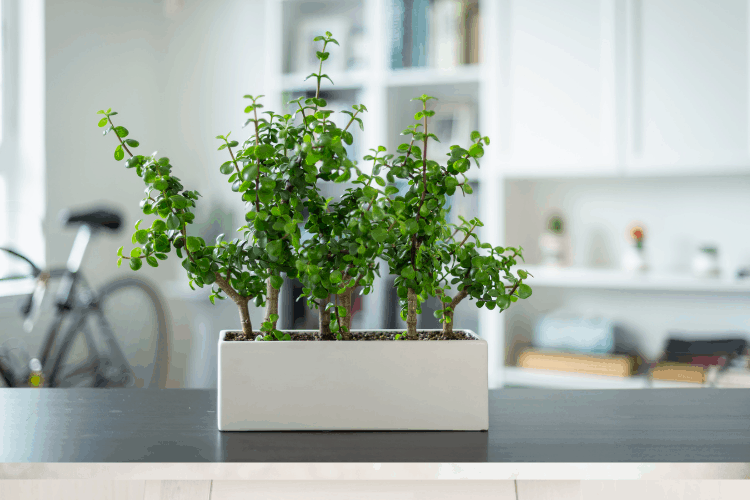
Once you’ve chosen the right species, it’s time to help them live their best lives! Here are a few tips to help you become the best plant parent ever.
- Match your plants with the right light conditions.
- Choose a planter that’s appropriately sized for your plant.
- Stick with top-quality potting soil.
- Pay attention to your plant’s watering needs.
- Regularly inspect for signs of insect pests.
- Keep plants away from drafty areas in your home.
- Keep foliage clean by dusting the leaves regularly.
- Rotate your plants every so often so they grow evenly.
- Fertilize houseplants in the spring and summer.
- Water plants in the sink, and then place back in the saucer.
By following these 10 guidelines, you can help make sure your indoor plants look great all year round!
Our Top Recommendations
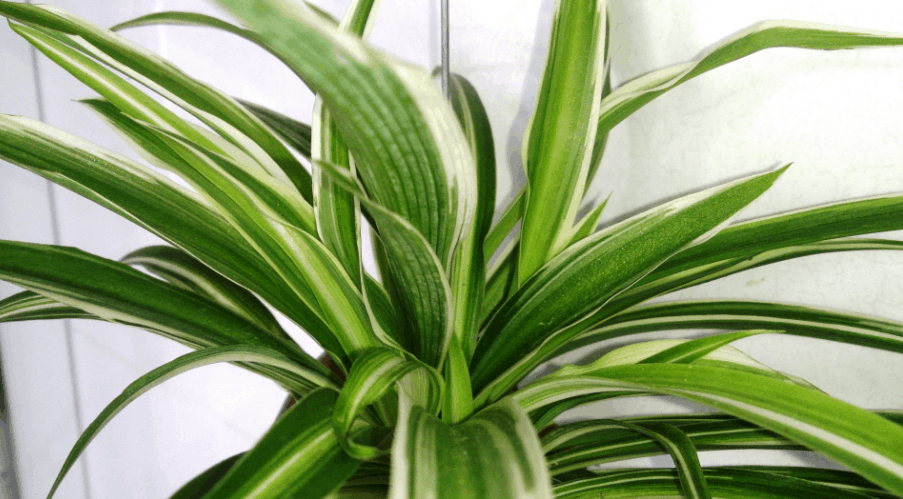
There’s no denying the number of options when it comes to shopping for an indoor plant. Here are our top recommendations when you’re ready to take that next step forward.
Spider Plant
Easy to grow and easy to share with others? This one earns top marks for its cool factor alone. Spider Plants are happy-go-lucky and look just as good perched on a bathroom shelf as they do hanging out on your kitchen countertop.
ZZ Plant
No time to water? No problem. This one made our top-five for its ability to survive with minimal moisture, as well as its ability to adapt to a variety of light levels. If you’re looking for an indoor plant that works on the “set it and forget it” method, then this one is it.
Pothos
There’s a reason why office workers around the country choose a Pothos Plant to brighten up their cubicle. Thriving even in low light and low-moisture conditions, these (and Philodendron Green) are a natural solution to any empty spot around your home.
Read More:
Rubber Plant
We love Rubber Plants for their height and drama. In many ways, they look very similar to the coveted Fiddle-Leaf Fig, but with drastically easier upkeep. As long as you keep their soil dry, these plants will surprise you with their impressive form.
Dracaena
Changes in your home environment might send some indoor plants running for the hills, but others hardly notice it. This is the case with the Dracaena, which can grow in almost any interior condition. It’s also one of the few houseplants that won’t miss you a bit if you go on vacation. As long as it banks enough hours of direct sunlight each day, it asks for little else.
FAQs
Question: Which is the best indoor plant to clean the air?
Answer: Are you eyeing a houseplant to help remove toxins and pollutants from your air? If so, the tried-and-true Pothos is a solid bet, as is the Dracaena, Rubber Plant, and Snake Plant. Peace Lillies and Boston Ferns are others to check out if this is a top priority.
Question: Which indoor plants are the easiest to keep alive?
Answer: Worried that your new plants will find out you only painted your thumb green? Look for forgiving houseplants that are easy for anyone to tend. Among other species, top ones to consider include:
• Spider Plants
• ZZ Plants
• Jade Plants
• Bromeliads
• Pothos
• Rabbit’s Ear
• Chinese Money Plant
The tag or description that accompanies each plant should thoroughly explain the level of upkeep, including watering, that the plant needs to survive. Reference this information to gauge whether or not it will be easy for you to keep alive.
Question: What are good first-time houseplants?
Answer: Are you a houseplant newbie? Everyone has to start somewhere, so let’s talk about species that are great for beginners.
On our list, Spider Plants, Philodendron, ZZ Plants, and Pathos are among the best for first-timers. Other easy indoor plants include the Barrel Cactus and Phalaenopsis Orchids. Don’t let the idea or instructions intimidate you, and look for ones that you find beautiful and practical.
Question: Do indoor plants like to be handled?
Answer: It might be tempting to touch your plants frequently, but it’s better to keep your hands off. Turns out, they don’t like it! In fact, even the slightest touch can trigger a major gene response in the plant.
Within minutes, this could affect and alter its permanent genome, which can ultimately stunt its growth. For this reason, it’s better to look but not touch (too much!).
Question: Can I put plants in my bedroom?
Answer: One of the reasons why plants are so good for your home is that they absorb carbon dioxide from the air, and release oxygen in its place. This takes place during the day when the plant is actively photosynthesizing.
At night, many houseplants absorb oxygen and release carbon dioxide. Some homeowners, especially those with sleep apnea, may worry that the plants can “rob” them of the essential oxygen in their bedroom.
This fear is understandable but invalid. Having a few plants in your bedroom won’t increase your carbon dioxide levels enough to cause harm. Plus, there are some plants that photosynthesize even at night, releasing valuable oxygen into the air. The Snake Plant is one of those plants, as are the Aloe Vera and Spider Plants.
Fill Your Home With Plants You Love
Your home is a blank slate. It gives you the opportunity to showcase your personality, live authentically, and retreat at the end of the day. Now that you know the best varieties of indoor plants to consider, you can start bringing in fresh greenery to inject even more life and vibrancy into your space.
Looking for more advice on how to choose and care for plants you’ll love? We have all the advice you need, so check back often for more updates!
Recommended Reads:
- Dragon Wing Begonia: How Long Can This Plant Last Indoors?
- Begonia Ferox: How Long It Takes For Begoniaceae To Sprout?
- Ficus Pumila: Is This Vining Plant Too Needy For Your Time?
- Rieger Begonia: What Can You Expect The Hiemalis Begonia To Flourish
- Escargot Begonia: Why Is The Rex Begonia So Rare?
- Peperomia Polybotrya: Is It Easy To Keep This Plant Alive?
- Peperomia Ginny: Why This Type Of Peperomia Is So Special?
- Peperomia Incana: Why The Felted Peperomia Is Perfect For Indoors?
- Strawberry Begonia: When It’s The Perfect Time To Propagate It?
- Philodendron Micans: Why You Need The Velvet Leaf Philodendron
- Philodendron Brasil: How To Propagate This Plant Easily?
- Peperomia Frost: Why Peperomia Caperata Is The Perfect Indoor Plant
- Pilea Microphylla: Where Should This Plant Be Placed In Your Home?
- Pilea Involucrata: Why You Need This Friendship Plant?
- Ficus Audrey: How to Turn This Plant Into a Majestic Tree
- Ficus Tineke: How to Care for The Rubber Tree Indoors
- Calathea Ornata: All You Need to Know About Caring of One
- Calathea Rattlesnake: Is It Easy to Grow It at Home?
- Peperomia Hope: How to Keep This Plant Healthy
- Philodendron Birkin: How to Take Care of the White Wave Plant
-
Peperomia Obtusifolia: Is the Baby Rubber Plant Perfect for Your Home?
